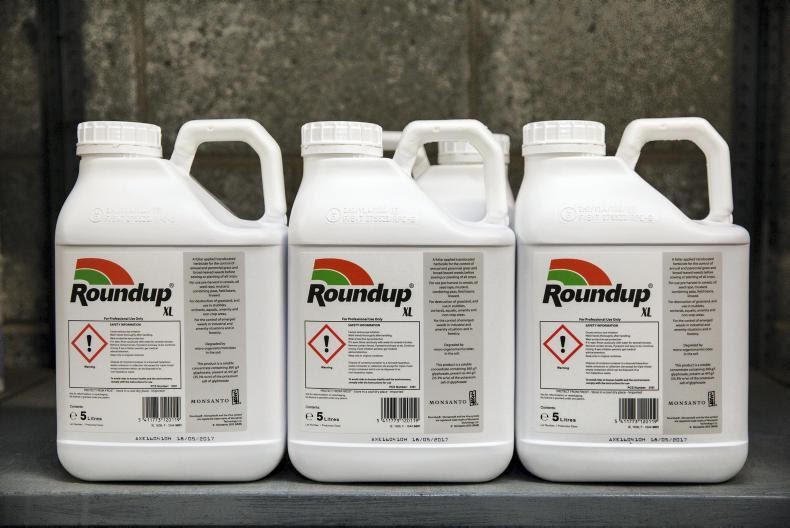In a new book out now, an academic examines the toxic effects of the weedkiller Glyphosate, hundreds of millions of lbs of which are used every year. She even claims that Glyphosate is becoming aerosolised through the use of biodiesel and that this may be responsible for many of the worst effects of the Coronavirus pandemic. Here we examine some of the most common claims about the negative health effects of the chemical.
In her new book, Toxic Legacy: How the Weedkiller Glyphosate is Destroying Our Health and the Environment, Stephanie Seneff describes the terrible ongoing effects of decades of massive use of Glyphosate in the US. Glyphosate is the active ingredient in Roundup, the most commonly used herbicide in the world. Nearly 300 million lbs of it are sprayed on farms and food every year.
One of the most eye-catching claims Seneff makes – and one that’s been much-discussed on Twitter in recent weeks – is that biodiesel made from crops sprayed with Glyphosate aerosolises the weedkiller, which is then inhaled. This damages the lungs, and this damage may be playing a role – yes, really – in exacerbating the Coronavirus pandemic. Recently, she discussed these claims as a guest on the Wise Traditions podcast, from the Weston Price Foundation.
McDonald’s makes a lot of noise about its efforts to power its delivery fleets using biodiesel
Aerosolised glyphosate making the Coronavirus pandemic worse!? Could this really be true? Such a striking claim is always likely to attract serious criticism, and Seneff’s claim has not proven the exception to this rule.
Putting aside this headline-grabbing claim, we’ll tell you what Glyphosate is and why, even if it isn’t helping drive the pandemic, it’s still almost certainly a very bad thing.
Glyphosate: What It Is and How It’s Used
Glyphosate is a broad-spectrum herbicide. It can’t be used to kill specific weeds or plants, but instead kills most broadleaf plants in the area it is used. It works by inhibiting the action of a plant enzyme that is needed for the production of three amino acids, which are essential to protein synthesis and growth. This is what kills the plant.
Glyphosate is absorbed into plants mainly through the leaves, and only tiny amounts of it are absorbed via the roots. As a result, glyphosate is only effective at killing growing weeds and grass, and cannot stop seeds from germinating. Once it is absorbed into the plant structure, glyphosate spreads all around the plant, to its roots and leaves.
In another article, we noted that Glyphosate was first developed by Monsanto as a means to replace the toxic endocrine-disrupting herbicide Atrazine. But that never happened, and now Atrazine and Glyphosate are most commonly used together in an ultra-toxic cocktail; if one chemical won’t kill the weed, the other will.
A map of Atrazine use in 2013. Note the concentration in the Corn Belt (Midwest). In agriculture, Glyphosate is most commonly used as part of a toxic cocktail with Atrazine, so a map of Glyphosate use would look almost identical to this.
Glyphosate is not only used on agricultural land, however. It’s used on public parks, school sports fields and in private gardens, just like Atrazine. And, of course, residues remain in the foods you eat, if they’ve been treated with it, and in the drinking water, as a result of run-off. Glyphosate is chemically stable in water and is not subject to photochemical degradation (i.e. it is not broken down by sunlight).
The sad truth is that, although you might think you’d be at greatest risk of exposure in agricultural areas like the Midwest where the chemical is used in its greatest concentrations, you can’t really escape Glyphosate. This is the story of life in the modern world when it comes to toxic chemicals, whether we’re talking about Glyphosate, Atrazine or xenoestrogens like pthalates and BPA. Recently, we reported that microplastics, which can carry a toxic freight of xenoestrogens, circulate globally on weather currents and can reach areas where even humans have yet to set foot.
Glyphosate Risks
There’s plenty of disagreement about the nature of the risks of Glyphosate, as you might expect with a commercial product that is worth so much money, directly for the companies that produce it and indirectly for the companies that use it to ensure their harvests.
At the very least, it’s beyond dispute that assessments like the following, taken from verywellhealth.com, are blithe in the extreme.
It’s also disingenuous to place a focus on tiny individual exposures, when the real fear is about repeated exposure over longer periods of time. The danger isn’t that one fast-food meal you ate containing a tiny amount of glyphosate residue, but years and decades of exposure through food, water and the broader environment.
It has been suggested that one method by which Glyphosate builds up in the body is by substitution with the amino acid glycine, so that the chemical is literally embedded in many of the proteins in your body.
One of the most persistent concerns with Glyphosate has been its potential carcinogenic properties from repeated exposure. According to public statements, Bayer Pharmaceuticals, which acquired Monsanto in 2018, is facing 125,000 lawsuits relating to health effects from Glyphosate.
Thousands of consumers have filed Roundup cancer claims alleging they developed non-Hodgkin’s lymphoma, b-cell lymphoma, leukemia and other forms of cancer after using the weed killer.
The first non-Hodgkin’s lymphoma lawsuit came before a jury in 2018 and resulted in a landmark $289 million verdict against Monsanto. The award has been reduced twice, but the plaintiff, Dewayne Johnson, and his family should receive $20 million.
(24) Glyphosate: ‘The most toxic product ever invented by man’ – YouTube
In 2020, Bayer agreed to a $10.9 billion dollar Roundup settlement, and has since put aside a further $2 billion for future lawsuits. Clearly, the claims are not going to keep coming.
A number of studies have linked Glyphosate exposure to increased risks of forms of cancer like Non-Hodgkin’s Lymphoma (NHL), in Europe and the United States. A 2019 study from the University of Washington, for instance, concluded that high exposure to Glyphosate increased a person’s risk of NHL by 41%.
There are other health concerns too, many of which relate to:
- Endocrine disruption
- Deficiencies in essential minerals
- Disruption of gut function, mainly as a result of overgrowth of pathogens in the gut, which can lead to immune problems and chronic inflammation
- Disruption of important biochemical processes, such as DNA methylation
- Neurotoxic damage
We think it’s safe to say that as long as there’s money to be made from Glyphosate, the claims of negative health effects will be disputed.
So what can you do to reduce your exposure? First of all, you can reduce or eliminate entirely all non-organic food from your diet. Processed food, in particular, is likely to contain Glyphosate (see this lab report of a test conducted on five popular products in the US), another reason why it should be avoided at all costs.
Even so, you should still wash all fruit and vegetables thoroughly, because cross-contamination can occur in a variety of different ways.
With regard to meat and meat-products, try to buy from trusted local sources. That way you can be sure not only that the animals are treated kindly but also that they aren’t given feed containing glyphosate.
Consider installing a reverse-osmosis water filter with a carbon filter for your drinking water.
As we said, though, with regard to xenoestrogens, it may be impossible to reduce your exposure totally. But the more you can remove this potentially carcinogenic chemical and others from your body and environment, the better off you’re likely to be.

Don’t hesitate to email us at [email protected] for personalized coaching and a client questionnaire if you’d like DEDICATED tailor-made personal training on strength training, building muscle, losing fat, developing athleticism, and more — all to your liking, lifestyle, habits, and taste!
Otherwise, don’t forget to claim your FREE eBook detailing how to lose 20lb of fat while building muscle in 12 weeks! You can claim it here.
Alternatively, you can pick up a FREE eBook on fundamental strength principles offering an introductory workout program.












